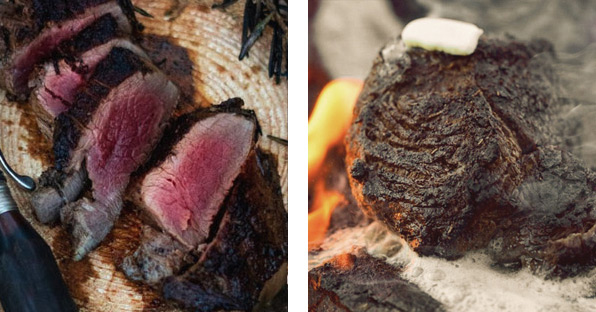Sheep Hunt
When you first arrive in real Goat Country, chances are you might be overwhelmed by the earth you encounter. Huge cliffs tower into the sky and white peaks contrast against deep blue while dark green timbers rise infinitely upon the slopes and waterfalls tumble down glistening rocks. You may find that this big world leaves you feeling small, insignificant.
Lean into your awe, safe in the knowledge that you can climb these slopes and cliffs, just as women and men have for centuries before you. Let yourself get lost in the sights and sounds of this untamed wilderness. Regardless of the outcome of your hunt, you’ll return with the incredible feat of having felt yourself, however briefly, completely at one with nature – the very foundation of any adventure.
Defining Characteristics

Rut Season: Late November—Mid December
Before the Hunt

SHOT PLACEMENT
 Broadside – heart
Broadside – heart
 Front – heart
Front – heart
SEASONS BY PROVINCE
| Prov. | Species | Dates | Cost | Guide Ref. |
|---|---|---|---|---|
| B.C. | Bighorn Mountain | Aug. 15–Oct. 25 | $60.00 | pg. 27–87 |
| Thinhorn Mountain | Aug. 15–Oct. 15 | $60.00 | pg. 27–87 | |
| AB | Bighorn Mountain | Aug. 25–Nov. 30 | $59.95 | pg. 45–54 |
| SK | N/A | N/A | N/A | N/A |
| MB | N/A | N/A | N/A | N/A |
| ON | N/A | N/A | N/A | N/A |
| QC | N/A | N/A | N/A | N/A |
| Prov. | Species | Dates | Cost | Guide Ref. |
|---|---|---|---|---|
| NB | N/A | N/A | N/A | N/A |
| NFLD | N/A | N/A | N/A | N/A |
| NS | N/A | N/A | N/A | N/A |
| NWT | Dall's | July 15–Oct. 31 | $22.00 | pg. 31 |
| YK | Dall's | Aug. 1–Oct. 31 | $10.00 | pg. 65–74 |
| NVT | N/A | N/A | N/A | N/A |
The information presented above is meant as a quick reference and does not represent all areas of residence, species and other regulatory requirements. Dates are subject to change based on management zone, animal class and hunter specifications. Please refer to the dates posted on each province’s/territory’s website, available by clicking on the province/territory name and referring to the 'Guide ref.' page numbers column.
After the Hunt
Contrary to the claims of a popular myth classifying mountain goat meat as inedible or of questionable culinary value, the meat that mountain goats yield is actually utterly delectable, provided the animal is hunted at the right time in the season. This common misconception stems from the stark contrast of the meat from mountain goats hunted early in the season, and the meat of those hunted late in the season. This magic threshold occurs in mid-October: wonderfully delicious before, and impossibly foul thereafter.
The meat of rutting mountain goat males (taken after mid-October), although clean and appetizing in appearance after proper butchering, emits a smell nauseating beyond belief after being placed in a pan, Dutch oven, or stockpot. In contrast, the meat of mountain goats taken up until mid-October, when hung for a few days or frozen soon after butchering, produces a deliciously tender feast.

The content on this page has been adapted from a chapter in Dr. Valerius Geist’s
Living on the Edge: The Mountain Goat’s World.
Deer
Of the five deer species found in Canada, White-Tail Deer are the most sought after by hunters. They are typically found in fields and meadows, relying on clusters of brush and trees for shade. During the winter, they typically prefer forested conditions to take shelter from the cold Canadian climate.
ELK
A full-grown bull elk can stand as tall as 9 feet, with antlers reaching 4 feet above their head. Don’t underestimate the sheer size and weight of these beautiful giants. Hunting elk can be a challenging, but intensely rewarding experience, providing you have the gear and know-how to get the job done.
Moose
A bull moose in full spread is one of the most imposing animals in the Canadian wilderness. Taller than a saddle horse, large bulls can weigh over 1300 pounds. Hunters who are brave enough to take down a full-grown moose are often rewarded with a large and impressive trophy.
Bear
An apex predator of the Canadian wild, black bears can weigh up to 600 pounds and boast impressive speed, agility and sense of smell. Take extra care when hunting these majestic, yet potentially dangerous creatures. Those who succeed are rewarded with a beautiful fur pelt, and a good story or two.


